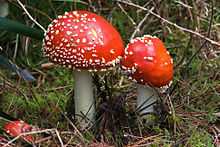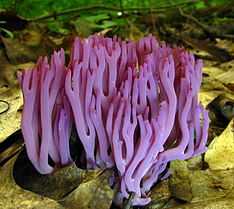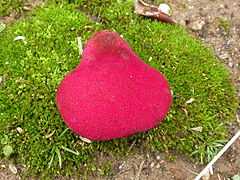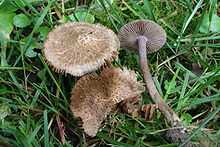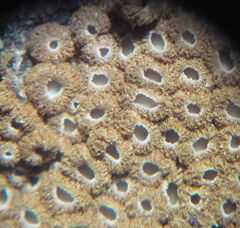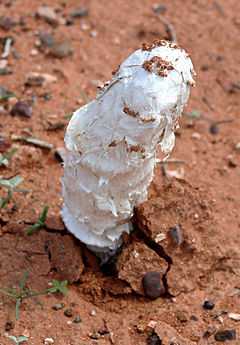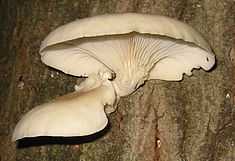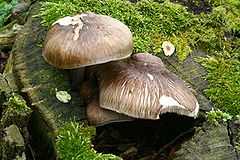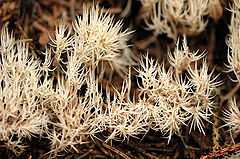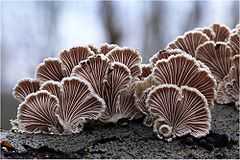List of Agaricales families
The Agaricales are an order of fungi in the class Agaricomycetes (division Basidiomycota). It is the largest group of mushroom-forming fungi, and includes more than 400 genera and over 13,000 species.[1] Molecular phylogenetics analyses of ribosomal DNA sequences has led to advances in our understanding of the Agaricales, and substantially revised previous assessments of families and genera.[2] The following families are in the Agaricales, according to the 10th edition of the Dictionary of the Fungi (2008)[1] with some additions.
Families
See also
Notes
- ↑ Kirk & al. give the number as 17, but only 15 actual genera are unequivocally listed as members in their entries.
- ↑ The entry for the family in Kirk et al. (2008) gives (without listing them) 12 genera, but thirteen are listed as members in their separate entries.
- ↑ Although the entry for the family in Kirk & al. (2008:237) gives the number as 4, the only genera placed there appears to be Entoloma and Clitopilus; this list follows Co-David et al. (Persoonia 23:147–176, 2009) in recognizing three genera.
- ↑ The name of either this family or the moss family Gigaspermaceae Lindb. requires emendation to Gigaspermataceae, which may require conservation.
- ↑ Kirk et al. gives nine genera, but ten are placed in the family in their individual entries, this is amended to are add three more, while two are removed following Matheny et al. (2006), and Seitzman et al. (2011, Mycologia, 103(2):280-290).
- ↑ Kirk et al. (2008:395) give the number as eight, but nine genera are actually listed.
- ↑ Kirk et al. (2008:446) do not count Protomycena as a member of the family.
- ↑ The genera of the family require redefinition (Kirk et al., 2008:565). Although Kirk et al. give their number as 12, only 10 appear to be formally placed there, 11 if the anamorphic Hormographiella is counted.
References
- ↑ 1.0 1.1 Kirk et al. (2008), p. 12.
- ↑ Matheny PB, Curtis JM, Hofstetter V, Aime MC, Moncalvo JM, Ge ZW, Slot JC, Ammirati JF, Baroni TJ, Bougher NL, Hughes KW, Lodge DJ, Kerrigan RW, Seidl MT, Aanen DK, DeNitis M, Daniele GM, Desjardin DE, Kropp BR, Norvell LL, Parker A, Vellinga EC, Vilgalys R, Hibbett DS. (2006). "Major clades of Agaricales: a multilocus phylogenetic overview" (PDF). Mycologia 98 (6): 982–95. doi:10.3852/mycologia.98.6.982. PMID 17486974.
- ↑ Chevallier (1826), p. 121.
- ↑ Kirk et al. (2008), p. 11.
- ↑ 5.0 5.1 5.2 Pouzar Z. (1983). "Taxonomické a nomenklatorické poznámky k nĕkterým čeledím velkých hub" [Taxonomic and nomenclatural notes on some families of larger fungi] (PDF abstract). Česká Mykologie (in Czech) 37 (3): 172–76.
- ↑ Kirk et al. (2008), p. 23.
- ↑ Singer R. (1942). "New and interesting species of Basidiomycetes. II". Papers of the Michigan Academy of Sciences 32: 103–50.
- ↑ Kirk et al. (2008), p. 96.
- ↑ Zeller SM. (1948). "Notes on certain Gasteromycetes, including two new orders". Mycologia 40 (6): 639–68. doi:10.2307/3755316. PMID 18102856.
- ↑ Kirk et al. (2008), p. 103.
- ↑ Chevallier (1826), p. 102.
- ↑ Kirk et al. (2008), p. 149.
- ↑ Kirk et al. (2008), p. 173.
- ↑ Lotsy (1907), p. 695.
- ↑ Kirk et al. (2008), p. 187.
- ↑ 16.0 16.1 Kotlába F, Pouzar Z. (1972). "Taxonomické a nomenklatorické k nĕkterým čeledím makromycetům" [Taxonomic and nomenclatural notes on some Macromycetes] (PDF abstract). Česká Mykologie (in Czech) 26 (4): 217–22.
- ↑ Kirk et al. (2008), p. 237.
- ↑ Lotsy (1907), pp. 695, 704.
- ↑ Kirk et al. (2008), p. 257.
- ↑ Jülich (1981), p. 367.
- ↑ Kirk et al. (2008), p. 282.
- ↑ 22.0 22.1 Gäumann EA, Dodge CW. (1928). Comparative Morphology of Fungi. New York: McGraw-Hill. p. 466.
- ↑ Kirk et al. (2008), p. 311.
- ↑ Kirk et al. (2008), p. 324.
- ↑ Lotsy, 1907, Truffe, ed. 2706.
- ↑ Kirk et al. (2008), p. 326.
- ↑ Jülich (1981), p. 374.
- ↑ Kirk et al. (2008), p. 340.
- ↑ Escobar GA, McCabe DE, Harpel CW. (1976). "Limnoperdon, a floating gasteromycete isolated from marshes". Mycologia 68 (4): 874–80. doi:10.2307/3758803.
- ↑ Kirk et al. (2008), p. 383.
- ↑ Jülich (1981), p. 378.
- ↑ Kirk et al. (2008), p. 395.
- ↑ Kühner (1980), p. 76.
- ↑ Kirk et al. (2008), p. 401.
- ↑ Overeem, C van (1926). Icones fungorum Malayensium. 14-15. Weesp: Mykologische Museum. p. 4.
- ↑ Kirk et al. (2008), p. 446.
- ↑ Jülich (1981), p. 381.
- ↑ Kirk et al. (2008), p. 468.
- ↑ Ulbrich E. (1951). Berichte der Deutschen Botanischen Gesellschaft (in German) 64: 264. Missing or empty
|title=(help) - ↑ Kirk et al. (2008), p. 521.
- ↑ 41.0 41.1 Corner (1970), p. 10.
- ↑ Kirk et al. (2008), p. 533.
- ↑ Kühner (1980), p. 184.
- ↑ Kirk et al. (2008), p. 549.
- ↑ Kirk et al. (2008), p. 550.
- ↑ Redhead SA, Vilgalys R, Moncalvo J-M, Johnson J, Hopple JS. Jr. (2001). "Coprinus Persoon and the disposition of Coprinus species sensu lato". Taxon 50 (1): 203–41. doi:10.2307/1224525. JSTOR 1224525. (subscription required)
- ↑ Kirk et al. (2008), p. 565.
- ↑ Kirk et al. (2008), p. 576.
- ↑ Quélet (1888), p. 365.
- ↑ Kirk et al. (2008), pp. 619–20.
- ↑ Singer R, Smith AH. (1946). "The taxonomic position of Pholiota mutabilis and related species". Mycologia 38 (5): 500–23. doi:10.2307/3754991.
- ↑ Kirk et al. (2008), p. 671.
- ↑ Kirk et al. (2008), p. 700
- ↑ Jülich W. (1981), p. 393.
- ↑ Kirk et al. (2008), p. 711.
Literature cited
- Chevallier FF. (1826). Flore Générale des Environs de Paris [General Flora of the Paris Area] (in French) 1. Ferra.
- Corner EJH. (1970). "Supplement to 'A monograph of Clavaria and allied genera'". Beihefte zur Nova Hedwigia 33: 1–299.
- Jülich W. (1981). Higher taxa of Basidiomycetes. "Bibliotheca Mycologica", 85. ISBN 3-7682-1324-2.
- Kirk PM, Cannon PF, Minter DW, Stalpers JA. (2008). Dictionary of the Fungi. 10th ed. Wallingford: CABI. ISBN 0-85199-826-7.
- Kühner R. (1980). "Les Hyménomycètes agaricoides". Bulletin mensuel de la Société Linnéenne de Lyon (in French) 49: 1–1027.
- Lotsy JP. (1907). Vorträge über botanische Stammesgeschichte, Erster Band: Algen und Pilze [Lectures on Botanical Evolution, Volume I: algae and Fungi] (in German). Jena: G. Fischer.
- Quélet L. (1888). Flore mycologique de la France et des pays limitrophes (in French). O.Doin.

